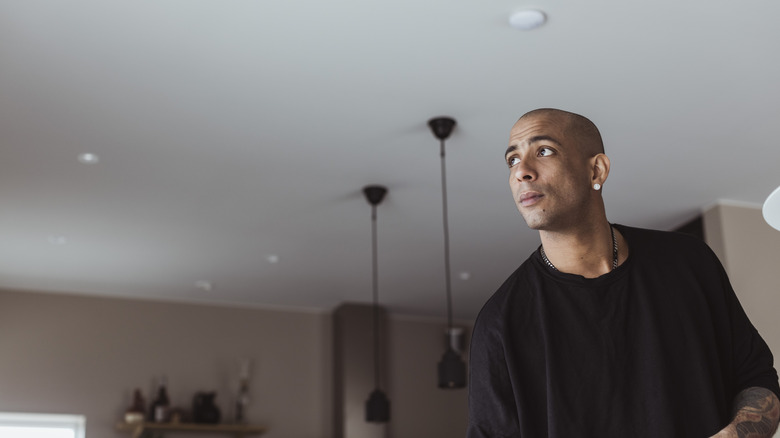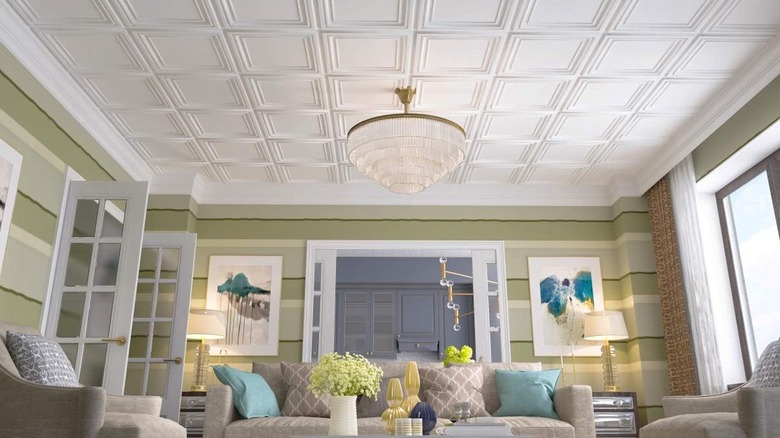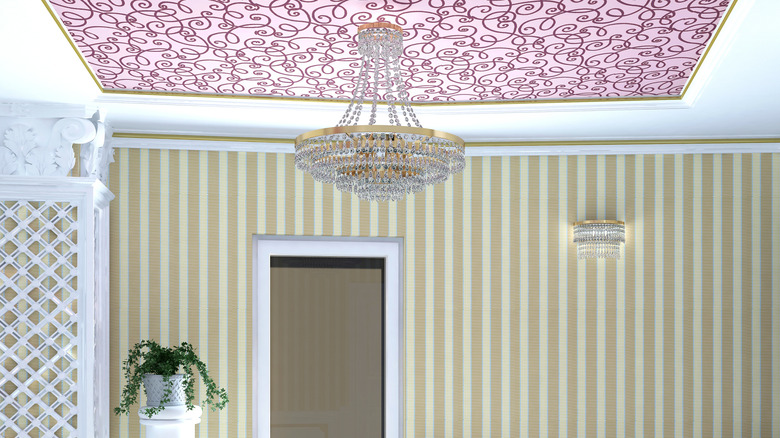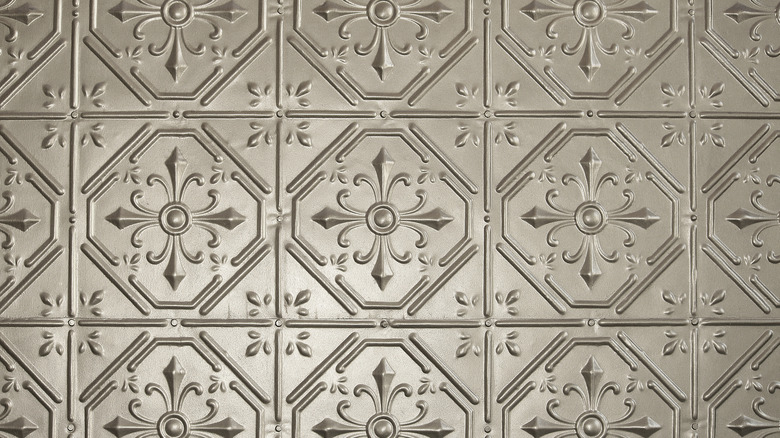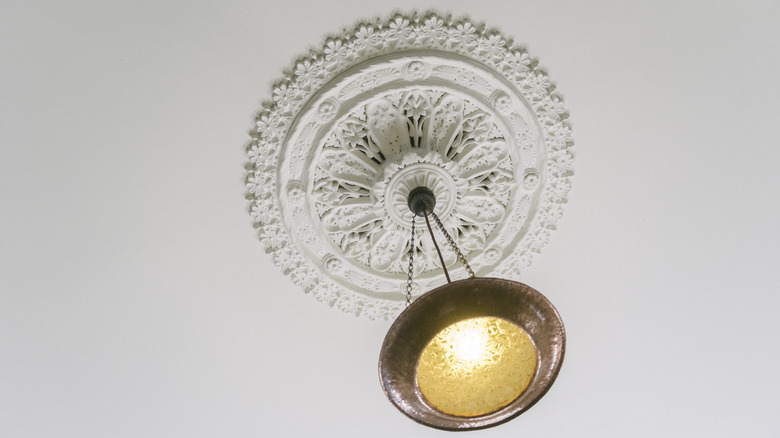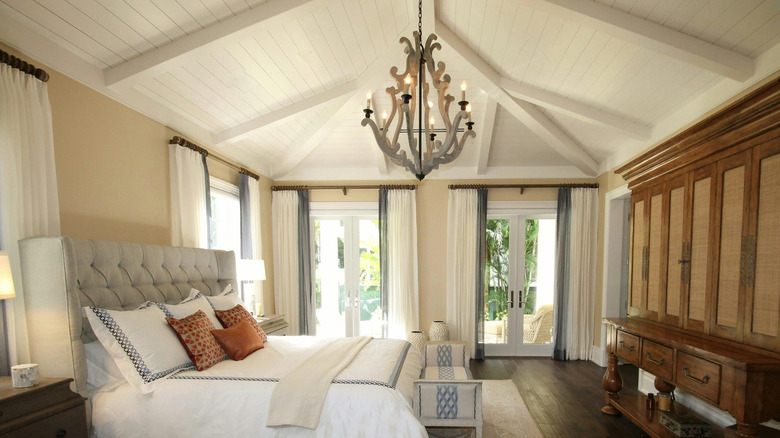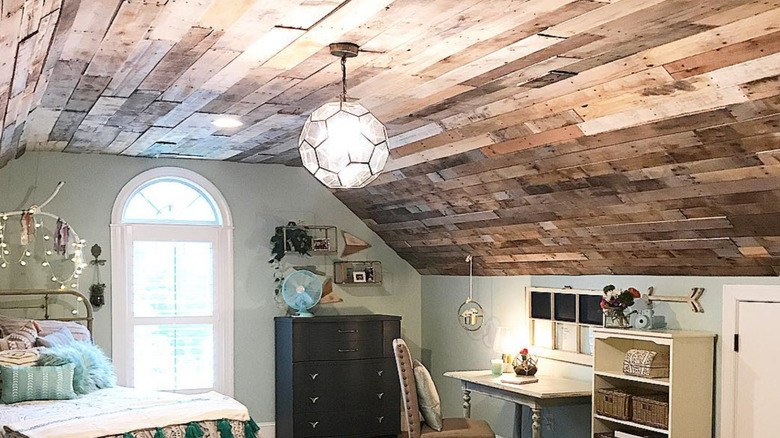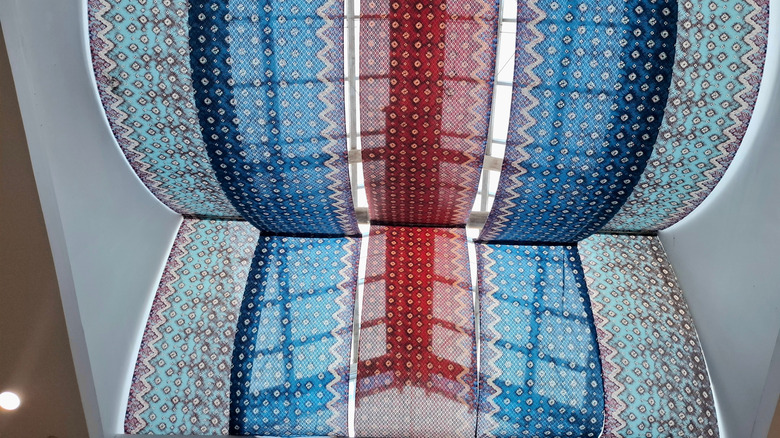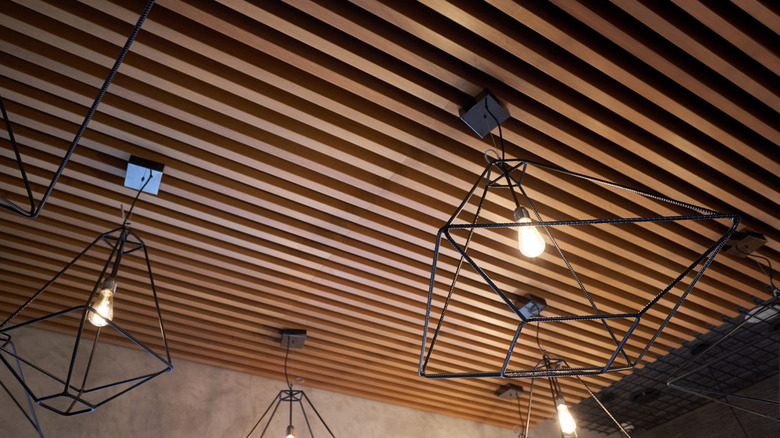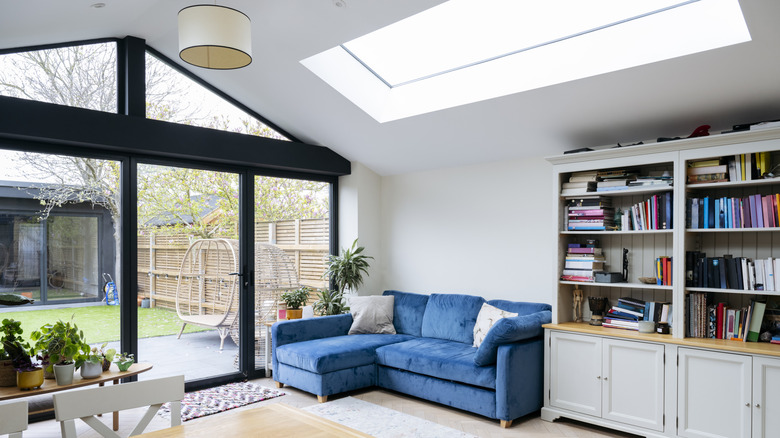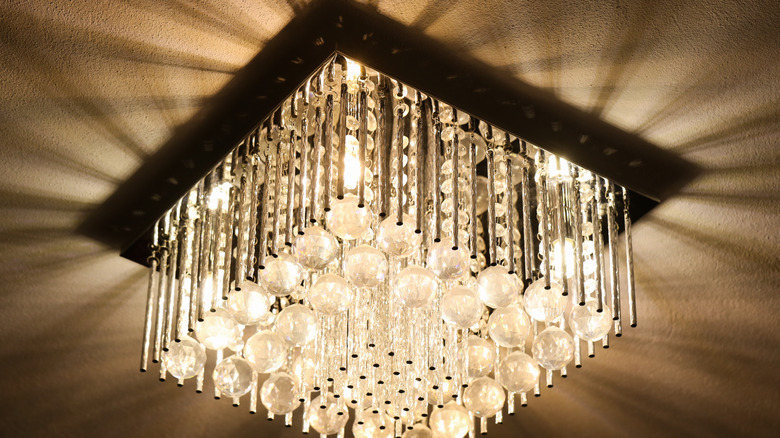10 Ways To Add Texture To Your Ceiling Without Using Paint
Are you ready to upgrade your boring ceilings without picking up a paintbrush? Along with adding drama and depth to any room, textured ceilings can reduce the noise in your home, soften loud or echoing spaces, and can cover up flaws or weirdly uneven spots. Temporary textured ceiling ideas, like peel-and-stick wallpaper or draped fabric, are extremely affordable and DIY-friendly. They're also great if you're renting and don't want to deal with the drop cloths, drying time, or a prolonged deposit hassle with your landlord. Wood slats or tin tiles are a little more involved but they're ideal when your flat white ceiling makes your entire space look lifeless. From classic beadboard to carved medallions, there are 10 creative ways to add texture to your drab ceiling without using paint you should consider if you're ready for a major transformation.
Before adding texture to your ceiling with an elaborate update or expensive materials, there are some practical considerations you should think through, especially if you plan to DIY. Be honest with yourself about your ability to work overhead for long periods of time, and whatever you do, make sure you have a stable ladder or scaffolding instead of relying on a wobbly step stool. Ceilings aren't always built the same way as walls, so if you're attaching heavy panels or slats, you'll need to carefully mark joists and use the right screws or anchors. And, you should also always check for overhead wiring before you start drilling to avoid costly or dangerous problems!
3D tiles
Drop ceilings often look downright ugly, especially when your builder-grade tiles are broken or stained. Fortunately, there are a wide variety of products like the Art3D PVC Ceiling Tiles that make it extremely simple to upgrade your drop ceiling for a modern look. Available in countless patterns and colors, once you get the hang of installing them, 3D tiles are a quick and stylish way to upgrade your space. If you love the look but your ceiling is flat, you can also simply glue the tiles into place.
Wallpaper
Wallpaper on the ceiling is a controversial trend, but whether you opt for a chintzy floral or a grooved grasscloth like JiffDiff Grassweave Self Adhesive Contact Paper, it's sure to add tons of texture to your space. With careful measuring, a sharp pair of scissors, and help from a patient friend, it's a relatively easy project to DIY. But from starting with a smooth surface to choosing the right roll, there are some important things to know before adding wallpaper to your ceiling.
Pressed tin tiles
Pressed tin ceilings originated in the late 1800s, but are still an extremely stylish alternative to paint today. Made from thin, stamped sheets of metal (which may or may not actually contain tin), the designs are typically ornate enough to add vintage charm and elegant texture that works in even the most modern interiors. More than just cosmetic, pressed tin tiles are also durable and easy to clean. They're also a fire-resistant option capable of containing fires for longer than other materials, which could help your family stay safe during an emergency.
Ceiling medallions
When you want to add texture to your ceiling but you prefer something understated, try framing a chandelier or pendant light with a ceiling medallion. Available in a range of materials, from costlier wood and plaster to relatively inexpensive polyurethane, you can find medallions in just about any size or design you can imagine. Along with looking especially elegant in historic homes or rooms with high ceilings, paring carefully placed ceiling medallions with ceiling trim can cover uneven, stained, or other problem areas with a lot less work than painting or embarking on a major structural change.
Shiplap
Installing a shiplap ceiling is one of the more involved projects you can do to add texture to your ceiling without using paint. The look works just as well in a coastal home as it does in a minimalist cabin. Hitting studs and using heavy-duty construction adhesive like Loctite PL Premium Polyurethane is a good idea to avoid getting an unpleasant wakeup call from boards that aren't adequately secured. If you absolutely want to avoid picking up a paintbrush, choose raw boards in a natural wood tone or opt for primed ones that add just the right amount of whitewashed chic to your space.
Reclaimed wood pallets
Another labor-intensive but highly rewarding way to add paint-free texture to your ceiling is by using reclaimed wood pallets. A great DIY project, you'll need to source plenty of pallet boards before securing each piece into place. First, you'll want to thoroughly clean your wood pallets. Once you're ready to install your boards, using a cordless tool like the NEU MASTER Battery Powered Nail Gun will make the job easier. For the best results, don't get too precious about each piece of wood. Instead, embrace the variety of tones, textures, and imperfections to create a rustic look that stands out.
Draped fabric
If you want an ethereal look in a bedroom, or you just need a way to filter sunshine that pours through a skylight, fabric is a simple way to add tons of texture to your ceilings. You can give your ceiling princess vibes by DIYing a vintage-inspired bedroom canopy that attaches with simple push pins. Draping lightweight fabrics made of linen will create a flowing effect, but you should incorporate thicker brocades (and use staples, hooks, or tension rods to hold them in place) if you need your fabric to do more heavy-lifting when it comes to room darkening and sound dampening.
Wood
There are a lot of ways to use wood for added texture on your ceiling, from installing real or faux wood beams like the Ekena Millwork Salvaged HeritageTimber to slats like the Art3D Fluted Acoustic Panels. Rough-hewn wood in warm tones adds vintage charm that's perfect if you're trying to nail the cottagecore look, while sleek walnut or onyx finishes are ideal in modern and minimalist homes. Either way, wood is heavy! Make sure you account for the added weight, and securely fasten every piece into a joist.
Skylight windows
While windows don't offer texture in the traditional sense, adding a skylight completely changes the way natural, ambient, and artificial light interact with your ceiling surface. No matter what kind of ceiling surface or color you're working with, introducing natural variation, movement, and shadows that change throughout the day can make incorporating a skylight a good option, especially if you have a low or flat space that feels closed off or dark. Designers Nate Berkus and Jeremiah Brent love a bright skylight in the kitchen. They're also excellent in bathrooms (just remember to prioritize moisture protection and venting to maximize your paint-free investment).
Lighting
It's hard to get totally on board with mirrored ceilings, which can look anywhere from dated to disturbing. But amplifying the light around your ceiling can change the way your room feels. Don't underestimate the power of lighting when it comes to adding texture (and even color!) without using paint. The simplest fixture can create tons of sparkle and shadow. Or, try installing a color-changing fixture like the TALOYA Smart Flush Mount Dimmable Ceiling Light, hanging string lights with flickering Edison bulbs, or even decorating with disco balls if you love the way mirrors and light dance on the ceiling.
